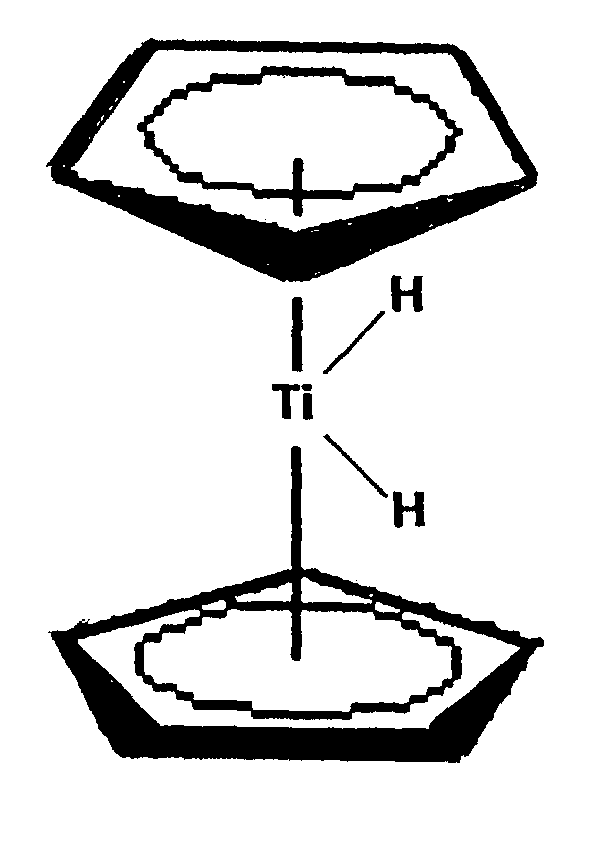Methods for hydrogen storage using doped alanate compositions
a technology of sodium aluminum hydride and hydrogen storage, which is applied in the direction of electrochemical generators, explosives, other chemical processes, etc., can solve the problems of limited practical implementation of hydrogen-powered economies, limited storage and release of hydrogen, and significant air quality problems, so as to achieve the effect of reducing heat loss
- Summary
- Abstract
- Description
- Claims
- Application Information
AI Technical Summary
Benefits of technology
Problems solved by technology
Method used
Image
Examples
example 1
Process for Making Doped Sodium Alanate
[0062]Sodium hydride and aluminum are obtained from Sigma / Aldrich Chemicals (St. Louis, Mo.). Bis(cyclopentadienyl) titanium dihydride (FIG. 1) is synthesized from dicyclopentadiene, which is heated to undergo a reverse Diels-Alder reaction. The resulting cyclopentadiene is reduced in the presence of titanium to yield bis(cyclopentadienyl) titanium dihydride (e.g., Whitesides et al., 1975). Alternatively, bis(cyclopentadienyl) titanium dihydride is prepared by the method of Bercaw et al. (1972). The components are added together in a molar ratio of 0.7 NaH to 1.0 aluminum to 0.1 bis(cyclopentadienyl) titanium dihydride. After brief mixing by magnetic stirring, the composition is packed into a container (e.g., cassette module) and heated to 190° C. for 30 min. The resulting porous sintered composition is used without further modification. The heating drives off the cyclopentadienyl component, leaving sodium, aluminum, titanium and hydrogen in th...
example 2
Cassette Module
[0063]FIG. 2 shows an exemplary embodiment of a cassette module (Hfuel™ A2 cassette) of use in the disclosed apparatus, methods and compositions. The cassette comprises an outer surface of electrically and thermally insulative, impact and chemical resistant plastic, with a single internal compartment holding about 1 liter of doped sodium alanate composition. In alternative embodiments, the outer casing is comprised of aluminum, ceramic, or an aluminum / ceramic composite. The alanate composition is surrounded by a series of layered materials, comprising an inner layer of flexible metalized plastic, a middle layer of Kevlar™, and an outer layer of Mylar, surrounded by a small gas (air) space and the outer rigid plastic cover. A hinged handle for inserting and removing the module from a hydrogen utilizing system is present at one end of the cassette. The other end of the cassette interfaces with the hydrogen utilizing system. In preferred embodiments, there is a single op...
example 3
[0065]In preferred embodiments, the cassette is designed as a modular unit to be inserted into a hydrogen utilizing system. An exemplary embodiment of a hydrogen utilizing system is illustrated in FIG. 3. As indicated, the cassette modules plug into a hydrogen utilizing system (Decom™ unit). In this illustrative embodiment, two Hfuel™ cassettes are inserted into a Decom™ system. The Decom™ system may be designed as a fully self-contained electrical power generator, feeding hydrogen gas generated by the cassettes to an internal fuel cell that may generate 6 or 12 volt direct current (DC) electrical power. In certain embodiments, the Decom™ unit may also comprise, or be attached to, an AC / DC converter that can provide 120 volt AC power to electrical devices. In other embodiments, the Decom™ unit may feed hydrogen gas to a combustion system, such as an ICE vehicle. In the exemplary embodiment shown in FIG. 3, the Decom™ unit is about 12″ deep, 6″ tall and 25″ w...
PUM
| Property | Measurement | Unit |
|---|---|---|
| molar ratios | aaaaa | aaaaa |
| molar ratio | aaaaa | aaaaa |
| molar ratio | aaaaa | aaaaa |
Abstract
Description
Claims
Application Information
 Login to View More
Login to View More - R&D
- Intellectual Property
- Life Sciences
- Materials
- Tech Scout
- Unparalleled Data Quality
- Higher Quality Content
- 60% Fewer Hallucinations
Browse by: Latest US Patents, China's latest patents, Technical Efficacy Thesaurus, Application Domain, Technology Topic, Popular Technical Reports.
© 2025 PatSnap. All rights reserved.Legal|Privacy policy|Modern Slavery Act Transparency Statement|Sitemap|About US| Contact US: help@patsnap.com



